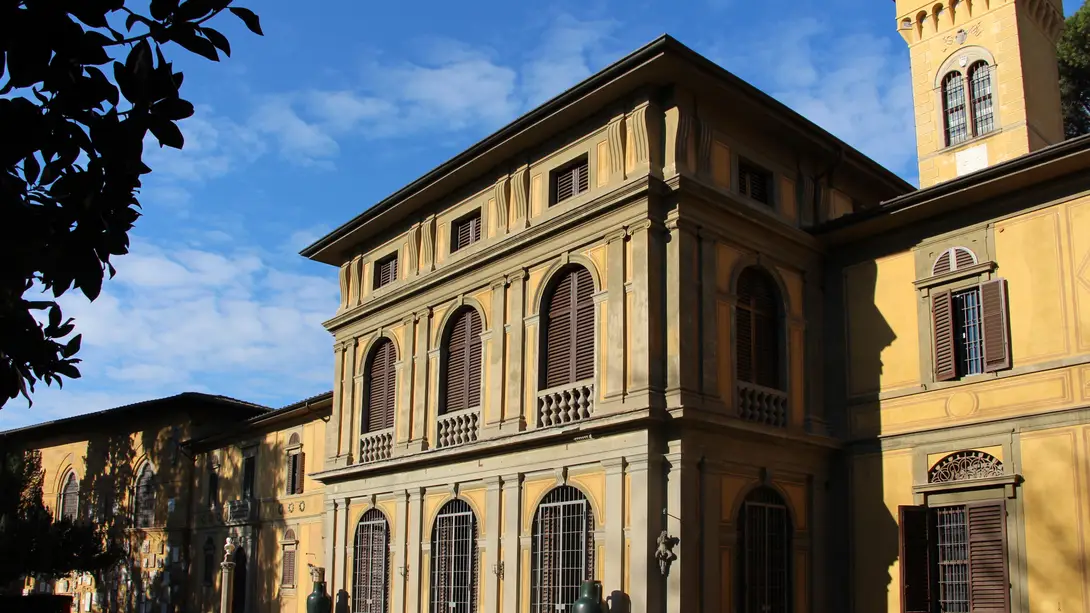
At the collectors' home
Among the many treasures that the city of Florence holds, there are those accumulated by collectors of the past and housed in buildings that were once residences or showrooms and have now become museums open to the public.
One should not think of these places as minor simply because they are not well known to the general public: these museums offer an insight into the diversity of cultural heritage, as well as providing a very original reason to visit.
On a map of the city, we place three of them near or directly on the banks of the Arno, and another outside the city centre, in the foothills surrounding Florence.
Our collectors are all gentlemen:
Stefano Bardini, Herbert Percy Horne, Rodolfo Siviero, and Frederick Stibbert.
Bardini characterises an entire section of the city, with the Museum in Via dei Renai, in the building that was his showroom as an antique dealer and connoisseur of works of art from the past. The walls are painted blue, Bardini blue to be precise, to highlight the colours of the paintings and the shapes of the sculptures. His presence continues in the Garden and the villa, not far away.
Horne purchased a Renaissance palace on the corner of Corso Tintori and Via dei Benci and furnished it like a home, with masterpieces of art and fine furniture from the 13th to the 17th centuries, where visitors can relive the past and discover the customs and traditions of the city of Florence.
Siviero, known as the secret agent of art, was concerned with saving masterpieces from the greed of the Nazi occupiers during the Second World War. His home is a small villa on Lungarno Serristori, where extraordinary works of art are on display, purchased by Siviero for his own pleasure, including both antiques and paintings by his contemporaries and friends.
Finally, Stibbert dedicated his family's residence, located on the hill of Montughi, to his collection of artworks and armour from all over the world, which he brought together in an extraordinary collection that he linked forever to the villa and the city of Florence.
Nicola Neri per Comune di Firenze
The places
Stages
Stefano Bardini Museum
The museum is named after its creator, the famous antiquarian Stefano Bardini. The old building that houses it, transformed with the neo-romantic taste of the time (around 1880), became the show-room of the ‘Prince of Antiquaries’.
This fascinating museum, off the beaten track, holds a collection of over 3600 works, including paintings, sculptures, armour, musical instruments, ceramics, coins, medals and antique furniture. Among the most important works are Tino di Camaino's Charity, Benedetto da Maiano's Madonna and Child with St. John the Baptist, Antonio del Pollaiolo's St. Michael the Archangel, Donatello's Madonna of the Ropes, and Guercino's Atlas.
Two rooms on the ground floor have been dedicated to Florence and its history, with some emblematic works from various places in the city: Pietro Tacca's very popular Boar (the bronze statue at the Mercato del Porcellino, "Piggy's market", is a copy), Giambologna's Diavolino from the crossroads between Via dei Vecchietti and Via Strozzi, and the gilded Marzocco from the architrave of Palazzo Vecchio.
The display denotes the eclectic taste of the owner; a characteristic detail is the painting of many walls in the typical blue, ‘blu Bardini’, used to highlight individual pieces, and imitated in many European courts. Also not to be missed, a stone's throw from the museum and still linked to the same figure, is the Bardini Villa & Garden.
Museo Horne
The museum houses the collection built up by Herbert Percy Horne, a collector and scholar of English origin who settled in Florence at the end of the 19th century. He furnished a small 15th-century palace with objects dating chiefly to the 14th–16th centuries. The collection includes fine paintings and sculptures (from Giotto to Simone Martini and from Masaccio to Giambologna), ceramics, jewellery and houseware, furniture, seals and fabrics, which recreate the atmosphere and appearance of a Renaissance dwelling.
The museum's Educational Service offers guided visits, creative and multimedia workshops based on involvement, participation and inclusion.
Casa Rodolfo Siviero
Rodolfo Siviero, who succeeded in bringing back to Italy hundreds of masterpieces that had disappeared during the Second World War, bequeathed his home and art collection to the Local Government of Regione Toscana.
Items range from ancient to more modern times: 15th-century wooden statues, gold-ground paintings, small bronzes, terracotta pieces, ancient reliquaries and furniture.
The 20th century also features with works by Giorgio de Chirico, Giacomo Manzù and Pietro Annigoni, all of whom were friends of Siviero.
Stibbert Museum
The Stibbert Museum, conceived by Frederick Stibbert (1838-1906), is a rare example of a 19th-century museum: an extraordinary collection of arms, armour and works of art is displayed in a series of rooms whose evocative layout was designed to evoke the atmosphere of the period and the places of origin of the various objects.
The collections include weapons, armour, costumes, objects of furniture and applied art, tapestries and paintings from the 16th to the 19th century, displayed in 60 rooms. The Sala della Cavalcata (the riding hall) is remarkable, where life-size European and Oriental knights are arrayed; the Japanese section includes, in addition to arms and armour, bronzes, costumes, lacquerware: it is one of the most important in the world outside Japan.
The park surrounding the villa, dotted with pavilions, statues, fake ruins and even a small Egyptian temple, reflects Stibbert's adherence to the romantic and eclectic taste typical of his time.



